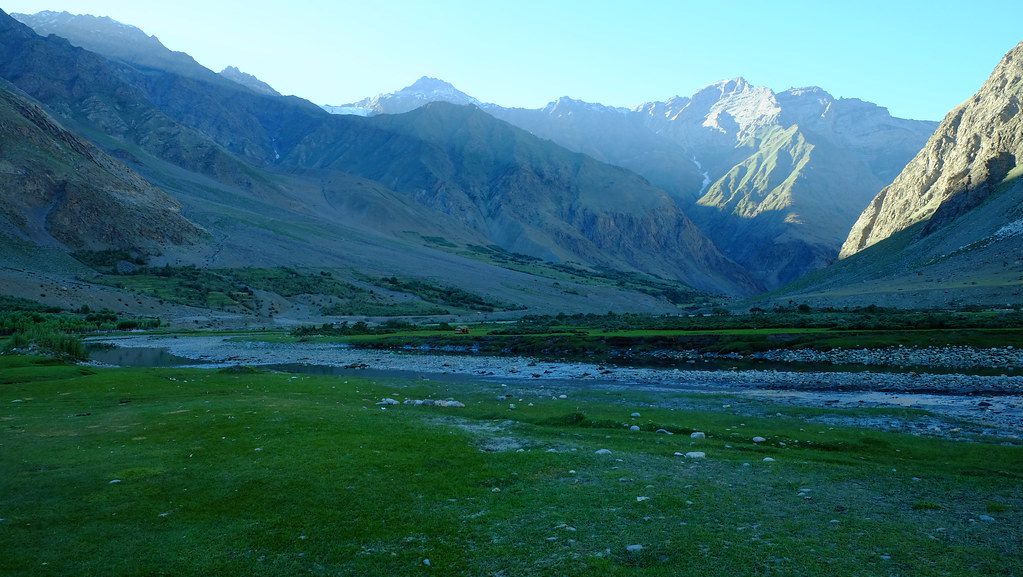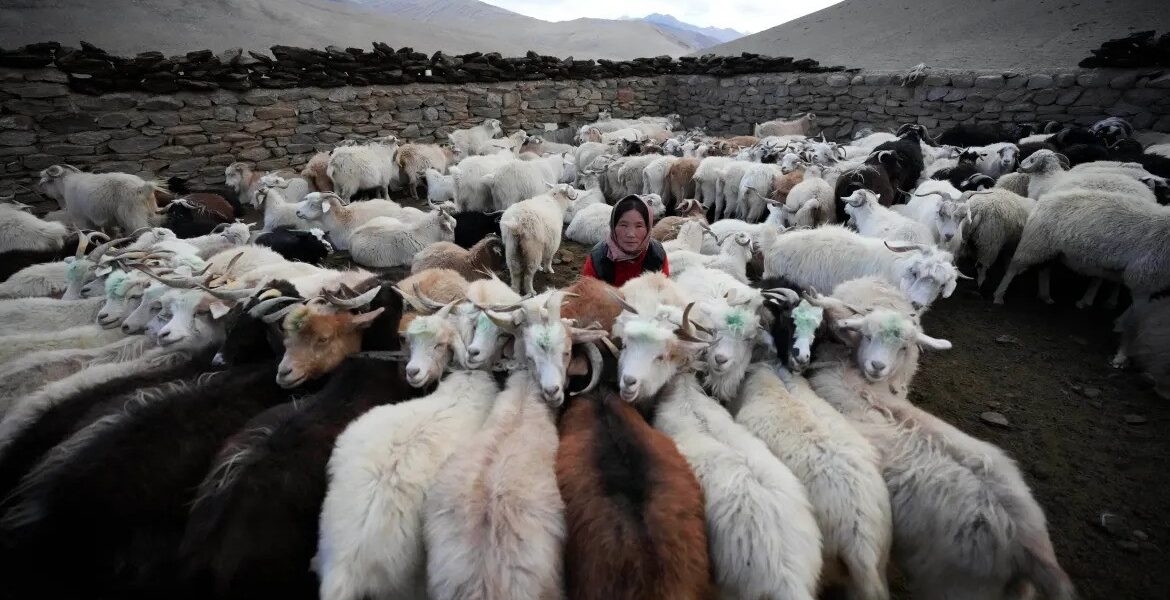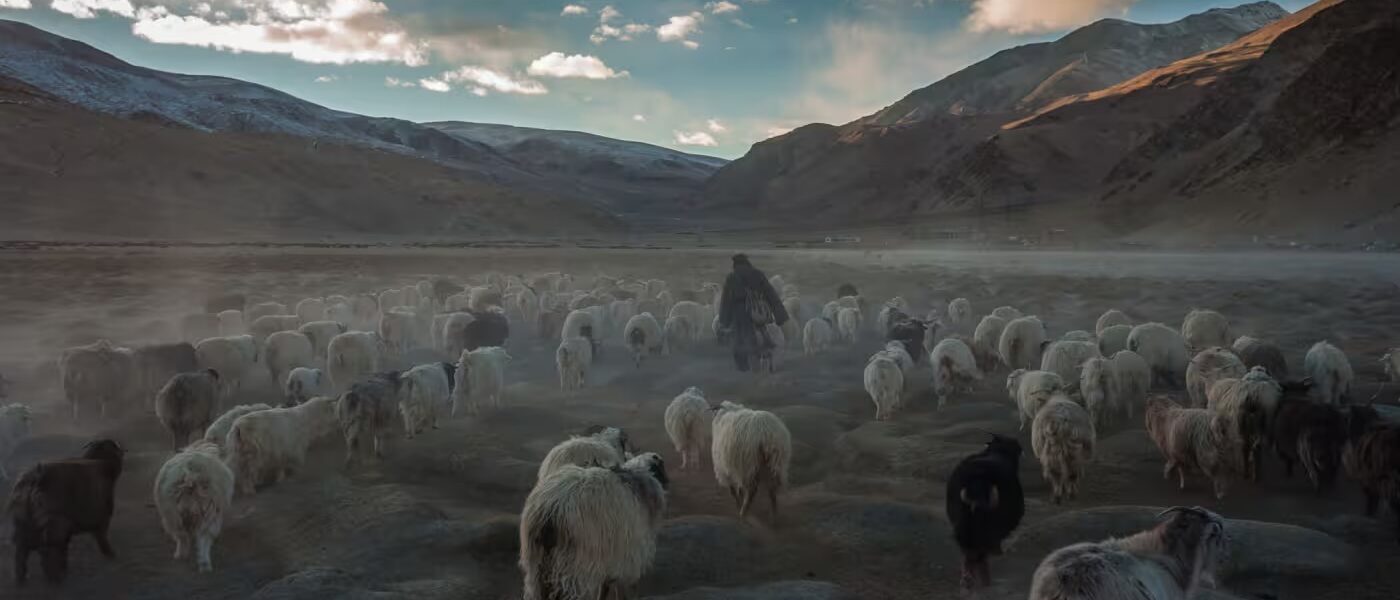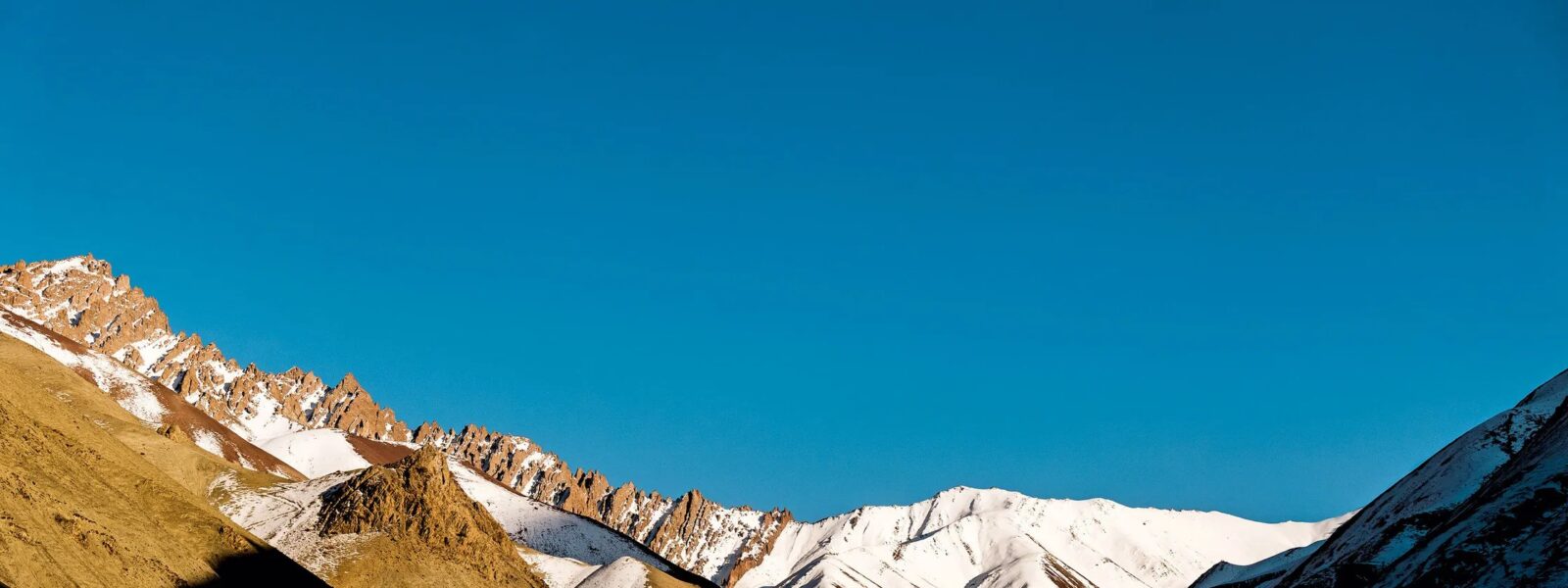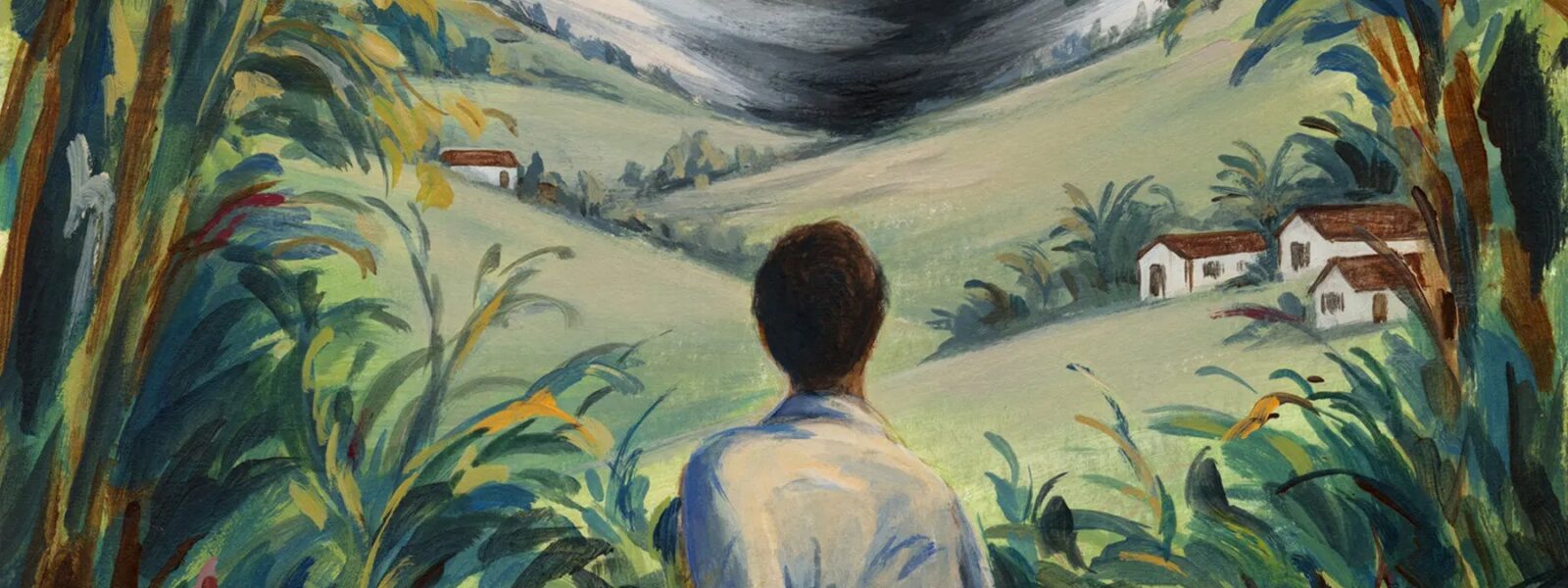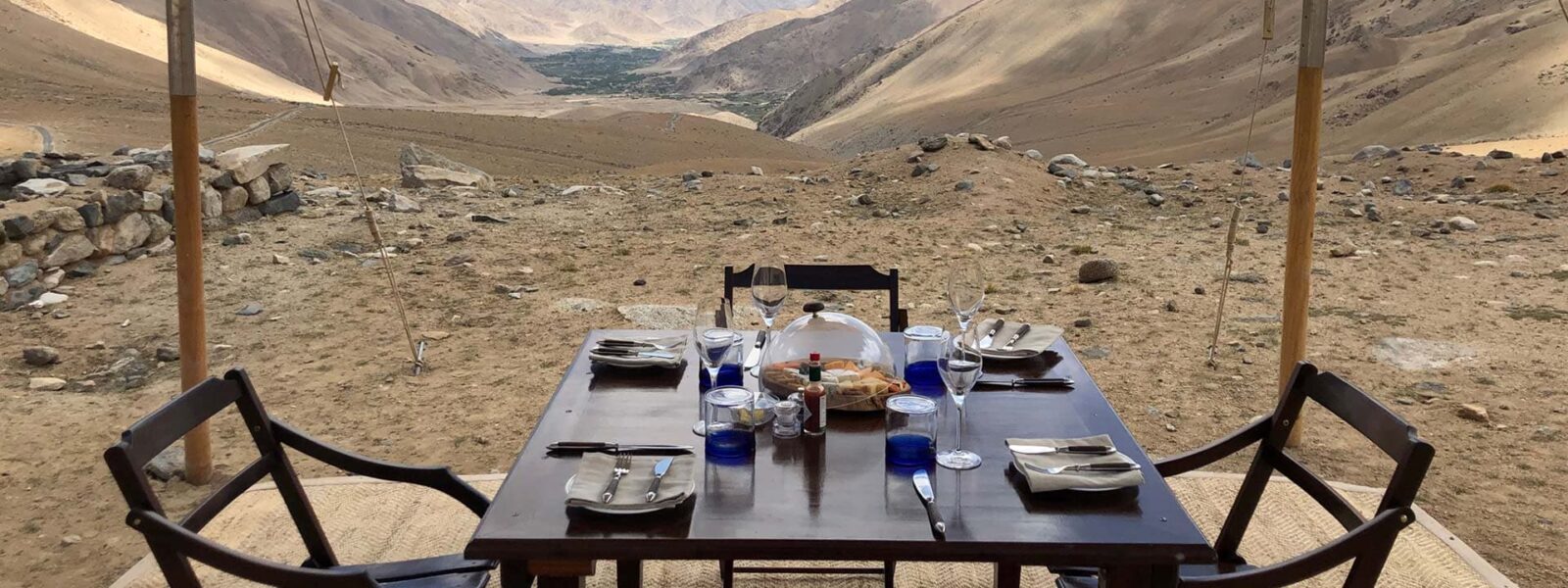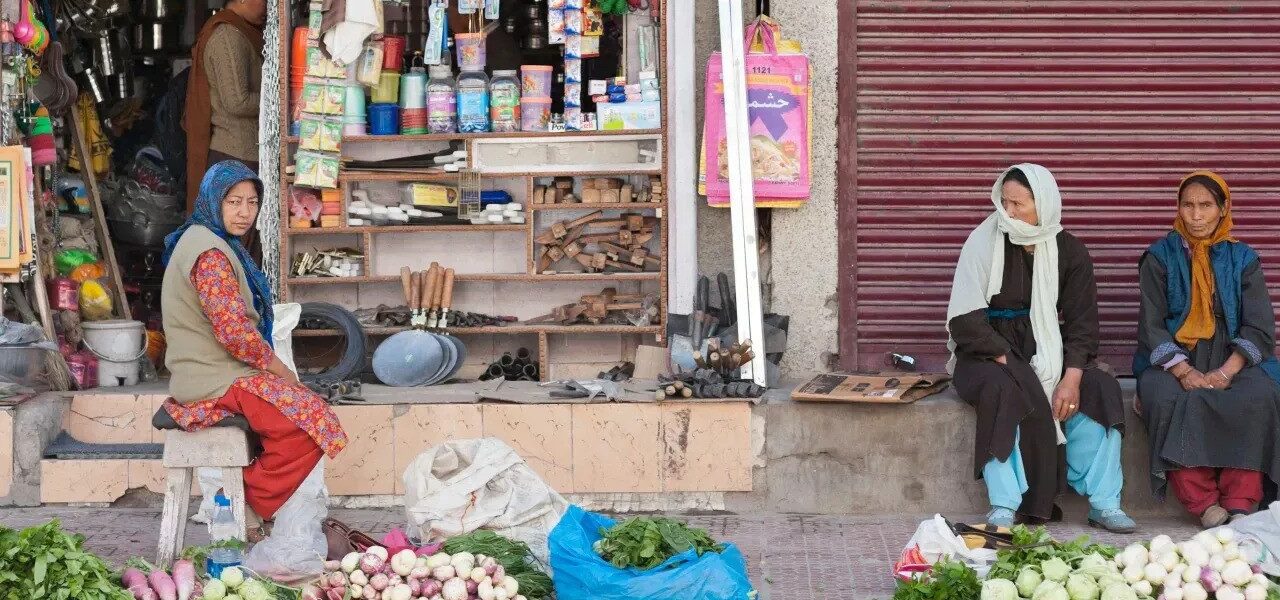A Village on the Edge of the Sky
The first thing you notice in Panikhar is the silence—not the absence of sound, but the presence of something larger, older. The air itself holds weight, as if it has not been stirred for centuries. A hush laid thick upon the stone walls and barley fields, disturbed only by the wind tracing its fingers across the peaks of the Suru Valley.
It is a village with no center. A scattering of whitewashed homes tucked beneath apricot trees, fed by streams that fall from unseen glaciers. In spring, the snow releases its hold and the rivers begin to speak again. Children chase goats across footpaths carved into mountain ridges. Women stand knee-deep in their fields, sleeves rolled, eyes fixed on a sky that feels close enough to touch.
Here, in this quiet fold of Ladakh, the sky is not above you—it is beside you. The altitude compresses the dome of blue into something immediate, visceral. Clouds hang like wool from shepherd’s hands. Sunsets bleed across the rocks. And at night, the stars do not twinkle; they pierce.
Most travelers pass through Panikhar without stopping, their eyes fixed on more famous names—Zanskar, Kargil, Leh. But those who pause, those who wander on foot through the narrow lanes, soon discover why the locals do not need windows. The mountains themselves are enough.
This is not a place of museums or monuments. It is a place of stone and wind, of seasonal memory, where time softens into rhythm and rhythm into rest. To walk here is to forget progress. To breathe here is to remember stillness.
And so begins the story of Panikhar—the Himalayan village where the roof recedes and the sky steps forward. For those seeking hidden gems in Ladakh, the journey ends not with arrival, but with the sky itself, leaning in to greet you.
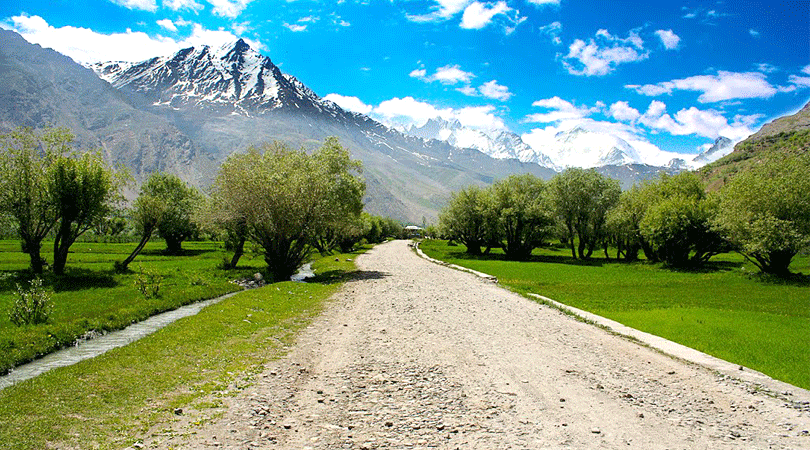
The Road that Climbs the Silence
There is a road that winds its way from Kargil to Panikhar, though “road” feels too heavy a word for something so fragile. It begins as tarmac, reliable and wide, but soon narrows into a ribbon of gravel that clings to the shoulder of the Suru River. On one side, cliffs rise like stone waves. On the other, the river glistens—an unfinished thought in motion.
No signs announce Panikhar. No shops line the way. Instead, the journey becomes a slow retreat from urgency. Mobile signals flicker and vanish. The air thins. The eye begins to adjust—not to screens or signs, but to light, distance, and shadow. This is not just the way to Panikhar—it is the way to losing the modern clock.
The road climbs, quietly. As you ascend, the sound of the river fades and is replaced by the low whisper of wind through alpine grass. You begin to feel the pressure of sky on bone. The Himalayan altitude presses gently against your thoughts, until even they become lighter, fewer, like prayer flags untethered.
Every few kilometers, a shepherd’s silhouette appears against the ridge. Yaks graze in motionless fields. Children wave without speaking. Their eyes follow you not with curiosity, but with stillness. As though they’ve seen many pass and most return too quickly to learn the language of silence.
Travelers often ask: “How long does it take to reach Panikhar from Kargil?” But there is no meaningful answer. Time behaves differently here. Distances stretch and compress. What matters is not arrival, but attunement—to the road’s curves, to the clouds above the Nun Kun peaks, to the small pauses that invite the soul to breathe.
This route is more than a passage through mountains. It is a passage into them. Into yourself. Into a geography that does not flatter or entertain but confronts gently, like a mirror held up by snow.
So when you come to Panikhar, know that you have not simply arrived. You have climbed a silence so wide it could only have been built by the sky itself.
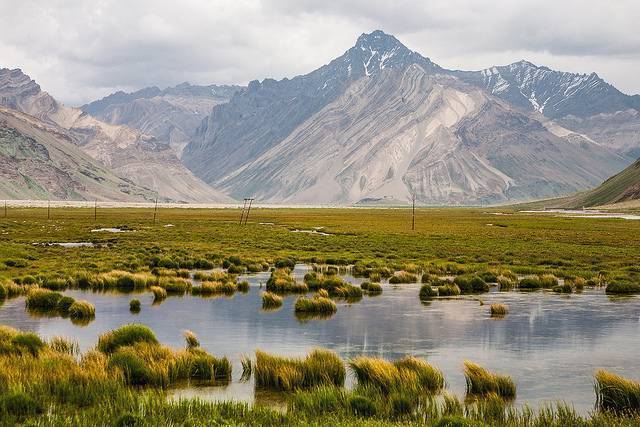
The Roofless Roof – Panikhar’s Sky
In most places, the sky is something you look up to. In Panikhar, the sky arrives uninvited, presses close, and stays. There is no ceiling to this village—only a vast, weightless presence hovering just above the treetops, grazing the tips of prayer flags, and falling softly onto the stone walls at dusk.
At an altitude above 10,000 feet, the horizon shifts. What once seemed endless now feels intimate. You no longer gaze into the sky—you walk beside it. And it walks beside you. The clouds are not overhead; they are eye-level companions, drifting slowly past like ancient pilgrims.
In the early morning, the sky blushes before the sun rises, as if embarrassed by its own beauty. The light here does not break—it melts. By midday, the blue becomes almost translucent, and shadows vanish into the brightness. Sky views in Ladakh are rarely so immersive, so close, so strangely grounding.
And then comes night. A slow collapse of color. As the last swallows fold themselves into silence, stars emerge with a clarity that defies logic. There is no haze, no flicker. Each constellation is stitched across the sky like a story that refuses to end. Stargazing in Panikhar is not an activity—it is a reckoning. A reminder of one’s scale. A return to cosmic perspective.
Locals do not speak of the sky often. They live with it, much as they live with stone and firewood. But listen closely, and you will hear them refer to it not with words, but with the rhythm of their days. They rise with its light, sleep with its quiet, and navigate life according to its moods.
Travelers sometimes search for peaceful Himalayan retreats, imagining spas and curated silence. But real serenity has no architecture. It is felt in the way the wind wraps your body on a ridge trail. In how the stars follow you down the path to your homestay. In how, for a brief time, the sky stops being something you look at—and becomes a place you live beneath.
To be in Panikhar is to understand what it means to have a roof that doesn’t interrupt the sky. Only here, in this remote Himalayan village, does the phrase “closer to the sky” feel not metaphorical, but measured.
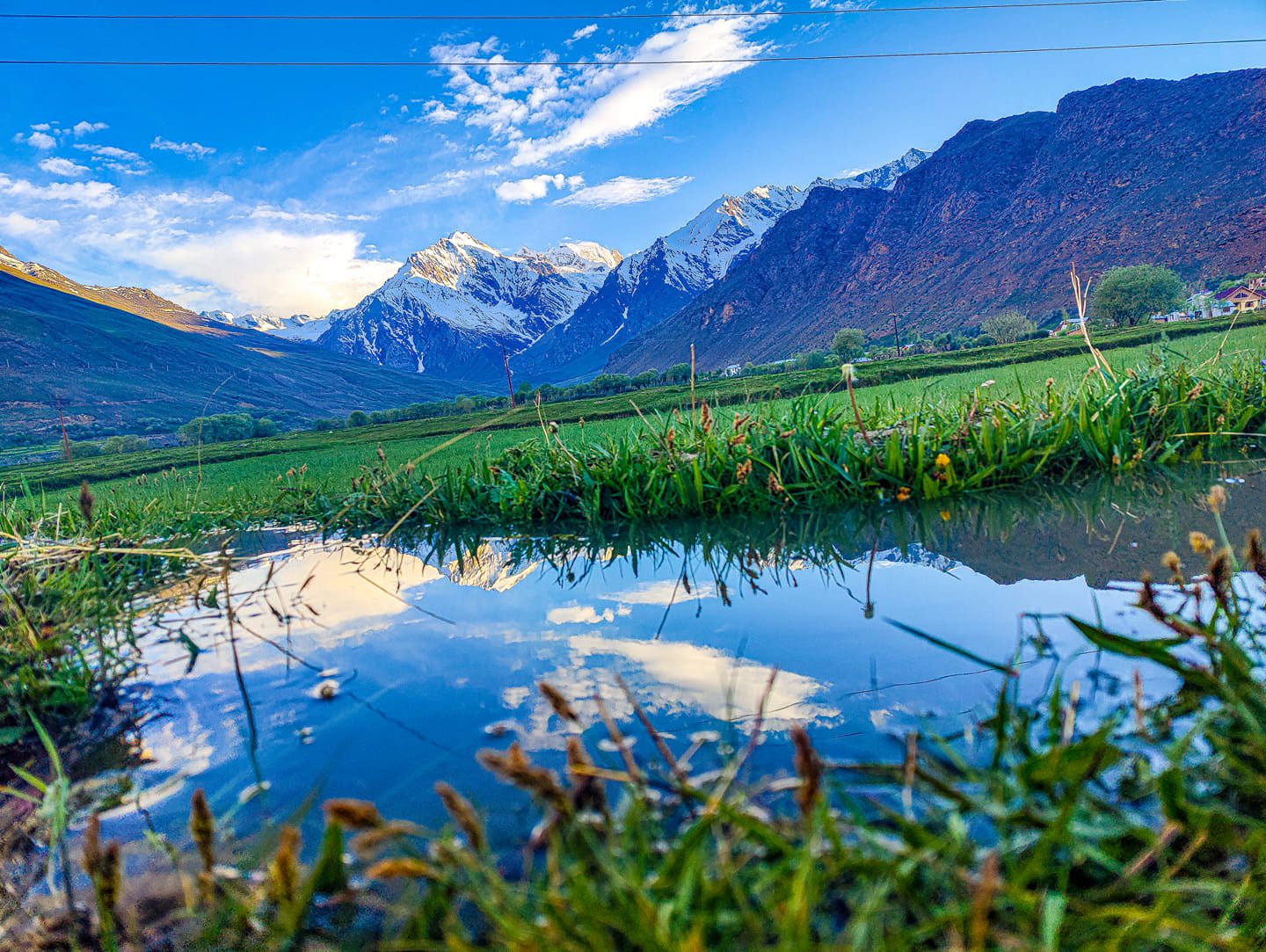
People of the Sky-Facing Slopes
In Panikhar, there are no loud voices. No rush of traffic. No cafes selling espresso. Instead, there are people who speak with their hands, who rise with the sun, and who understand the rhythms of wind and water better than they do the concept of time.
These are the people of the sky-facing slopes. Their lives are written into the earth they till, into the stones they stack, into the fields of barley they coax from the frozen soil. Their homes, low and white, wear flat roofs like quiet crowns. Traditional Ladakhi architecture favors practicality over display—a style born not from trends, but from wind, snow, and generations of knowing how to survive at 10,000 feet.
The village breathes slowly. In spring, the men repair the canals that carry glacial water to the fields. In summer, women gather apricots in woven baskets. In autumn, they thresh wheat with song. In winter, they wait—reading the mood of the mountains in silence.
Children here learn more from animals than from books. They know how to walk barefoot over gravel. How to find warmth in stone. How to follow a yak without a word. Their classrooms are meadows. Their toys are shaped from wool and wood.
To an outsider, this life may appear austere. But that is only if you are looking for distraction. There is none. There is only attention. To weather. To soil. To the changing angle of light as the day leans westward. In Panikhar, you do not fill time—you live inside it.
This is not the rural life in the Himalayas sold in brochures. It is not curated or idealized. It is intimate, raw, and entirely real. In the pauses between conversation, you begin to understand a deeper language—one that speaks not in sentences but in gestures, in shared meals, in a bowl of gur-gur chai offered without ceremony.
There is beauty here, but it is not the kind you frame. It is the kind you carry—soft, quiet, and enduring. And once you leave, it stays. Not in your photos, but in the way you wake early. In how you walk slower. In how you begin to notice the sky, and how the people beneath it always looked upward—not for escape, but for balance.
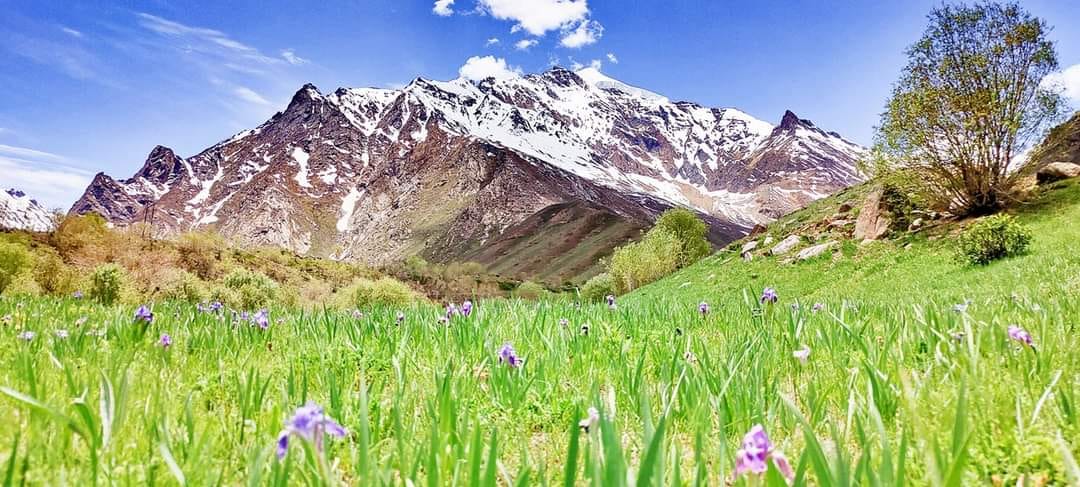
Where the Mountains Reflect Memory
There is a stream in Panikhar that holds the mountains in its arms. On calm days, it turns to glass—so still that the sky forgets which side is up. You kneel beside it not to drink, but to listen. For in this water, there are reflections that do not vanish. They stay with you, like the afterimage of a dream.
The Nun and Kun peaks stand eternal in the south, their faces white with snow and history. In the early morning, just before the village begins to stir, the light crawls across their flanks like the first memory of fire. You don’t watch the sunrise—you feel it. It begins inside your chest, spreads into your shoulders, and finally out toward the ridge line, where day waits patiently to begin.
It is here that the mountains seem to speak—not in voice, but in shape, in outline, in presence. They do not impose; they remember. Every curve has seen centuries of footsteps. Every shadow has waited through winters no traveler has known. To photograph them is to attempt the impossible: to hold still something that has never moved, yet has changed you entirely.
For those seeking photography spots in Suru Valley, Panikhar offers no dramatic signs. There are no fences or marked view points. But find your way to the water’s edge, and you will see it: the reflection of the mountains and the memory of your own stillness. Not just a view, but a revelation.
Shepherds here rarely carry cameras, but their eyes record everything—the slow roll of clouds, the way a crow lands on a prayer stone, the glint of frost in a child’s braid. Their memories are not digital. They are carved in rhythm, stored in silence.
The traveler who hurries will miss this. The one who lingers, however, may begin to notice that the landscape is not looking back—it is remembering. Your presence joins it briefly, then vanishes, like mist over the fields.
And so, the mountains of Panikhar remain—unmoving, unspoken, and unforgettable. They are not background. They are witness. They hold the echo of every visitor, the imprint of every moment. And if you let them, they will remember you too.
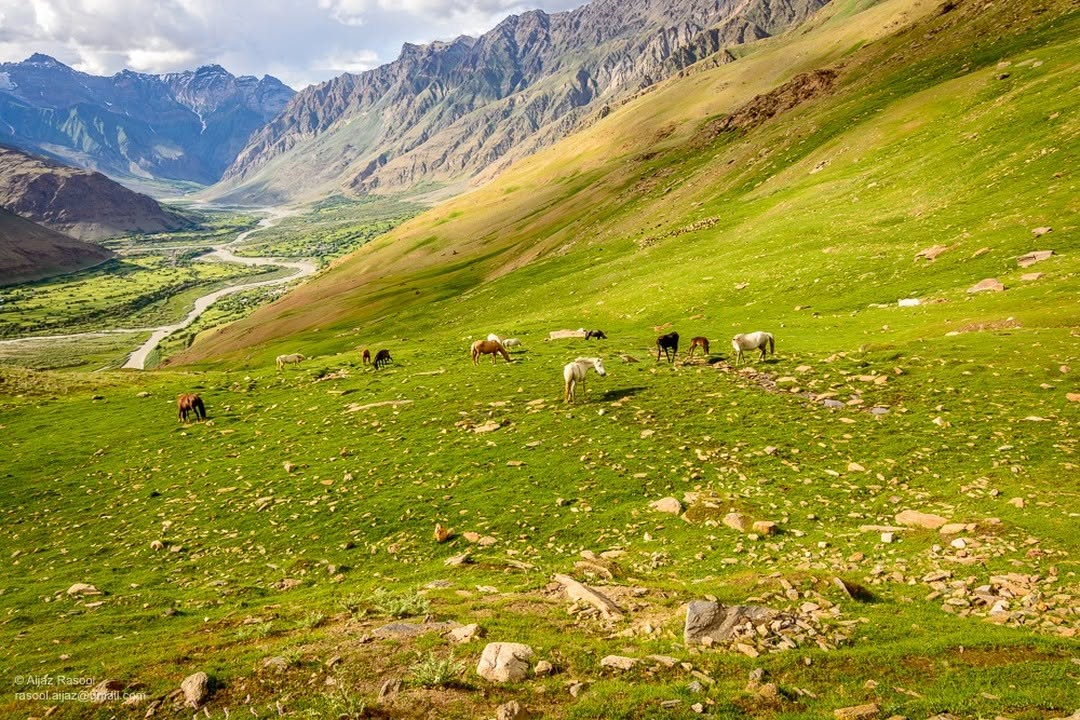
The Trail that Begins in Stillness
Most trails announce themselves—with signboards, footsteps, the scent of chai from distant stalls. But the trail that begins in Panikhar does not. It starts quietly, with a narrowing of space between homes, a foot-worn path beside a stone wall, and the absence of conversation.
You walk not toward a destination, but into a mood. One shaped by altitude, wind, and patience. Each step echoes in the ribs. The land does not unfold quickly—it waits for you to slow down. And once you do, it begins to offer its details: the shape of a shepherd’s staff resting against a rock, the pattern of frost on a juniper branch, the faint imprint of a hoof in dried mud.
From Panikhar, you can reach places like Parkachik or further toward the Zanskar frontier, but names feel unimportant out here. What matters is not where the path goes, but how it feels beneath your feet. These are not “routes” in the modern sense. These are footpaths—ancient, improvised, often invisible. And yet, they know the way better than you do.
For those seeking trekking routes in Suru Valley, this is not a place of signage or schedule. It is a place where the land whispers the next step, and where your journey is dictated not by GPS, but by instinct. To walk here is to remember that your body once knew how to listen to terrain.
There is no performance in this landscape. The mountains do not rise for you. The silence does not deepen for dramatic effect. But if you walk long enough, the sky will shift. The air will thicken. The view will open, not all at once, but gently, like a story being told by someone who trusts you.
In this way, Panikhar becomes not just a village, but a beginning. For the solitary traveler, the pilgrim, or the quiet-hearted trekker, it is a threshold—not from civilization to wilderness, but from noise to knowing. One does not conquer the Himalayas here. One enters them.
So let your first step be a soft one. Let it echo not forward, but inward. For in Panikhar, every trail begins in stillness, and stillness is the only map you need.
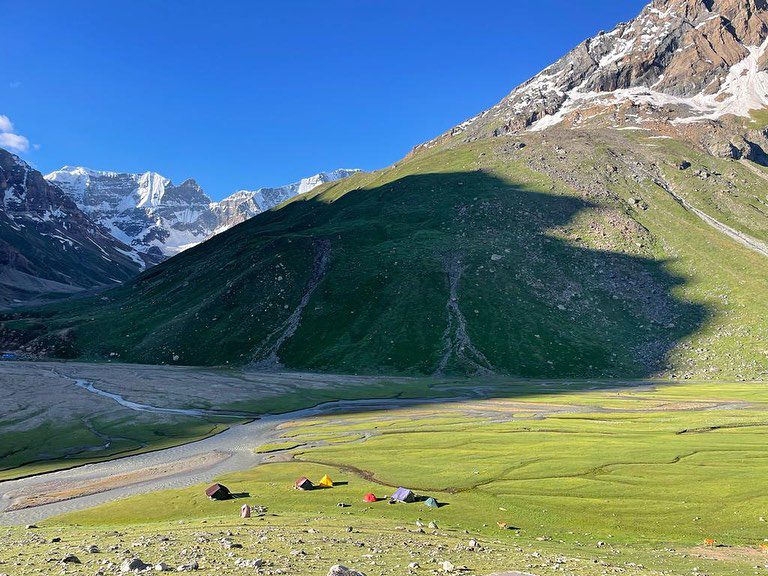
Staying Under the Stars
There are no hotels in Panikhar. No reception desks, no lobby music, no rooms numbered in sequence. Instead, there are homes—quiet, lived-in, and warmed by the breath of their own history. To stay here is not to check in, but to be invited in.
A homestay in Suru Valley is not an accommodation—it is an exchange. You bring your stories and your silence. They offer bread, warmth, and a bed beneath a sky that breathes stars. The walls are thick, made of stone and time. The ceilings low, to keep the heat close. There may be no bathroom mirror, but there is always a window—one that frames a glacier or a tree or a goat on the roof.
Here, hospitality is not a service but a rhythm. You are fed without being asked what you want. You are shown where to sleep without keys or paperwork. In the morning, you may find your host already outside, preparing tea beside the hearth. No words are needed. The gesture says enough.
For those seeking peaceful Himalayan retreats, Panikhar offers something rarer than luxury: presence. There is no Wi-Fi, but there is weather. There are no minibars, but there are apricots drying on the windowsill. There is no television, but the moonlight shifts its angle every hour, and the dog across the stream howls in time with the wind.
Night here arrives slowly. As the last of the light recedes behind the ridge, the village dims to candle-glow. Lamps are lit. Doors are shut. The silence thickens. Outside, the sky opens—immense and weightless. To sleep in Panikhar is to sleep under a roof that barely separates you from the stars.
The concept of eco-tourism in Ladakh is often framed by policy, but here, it is simply a way of life. Water is drawn, not wasted. Food is grown, not packaged. Plastic is absent, not recycled. The village does not know the language of sustainability—it practices it by inheritance.
In the morning, you rise not to alarms, but to the hush of light against the window. You wash your face in meltwater. You drink tea sweetened with yak milk. And you realize: you were not just staying in Panikhar. You were staying with Panikhar.

When to Go: Reading the Sky’s Calendar
Panikhar does not live by the months. It lives by melt, by thaw, by the return of light to the high slopes. There are no billboards announcing the season, no charts to consult. Instead, the village reads its calendar in the curve of the sun’s path, in the color of the river, in the scent of the wind.
For travelers wondering the best time to visit Panikhar, the answer depends on what kind of silence you’re looking for. In late spring—May into June—the valley awakens. Ice releases its grip on the fields. The first flowers emerge, shyly, in the crevices of stone. Shepherds return to the higher pastures, and the trails reopen like old memories unfolding.
Summer, from late June to early September, offers the clearest skies and warmest days. This is when Suru Valley weather is most forgiving. The light is long, the nights gentle. It is the season of long walks, mountain reflections, and the hum of bees among the barley.
But with every gift, the mountains ask for something in return. In autumn, the winds return. The sky sharpens. The sun withdraws sooner. There is beauty, yes—but also an edge. Leaves turn bronze. Shadows stretch. The trails empty. And Panikhar prepares once again for its long hush.
Winter is not for visitors. The roads close, snow seals the rooftops, and the valley retreats into itself. The people gather by hearths. The animals move less. The sky becomes a lid, and time becomes breath. Few outsiders witness this season, but those who do, speak of it in whispers, as if describing a dream.
If you come, come with awareness. The Ladakh travel seasons are not about discounts or festivals. They are about harmony—with the altitude, with the pace, with the sky. Pack not just for the weather, but for the slowness. The waiting. The listening.
Because here in Panikhar, you do not schedule your visit by dates. You wait until the land opens its hand. And when it does, you step into it lightly—like someone entering a room where the sky is the host and you are simply the guest.
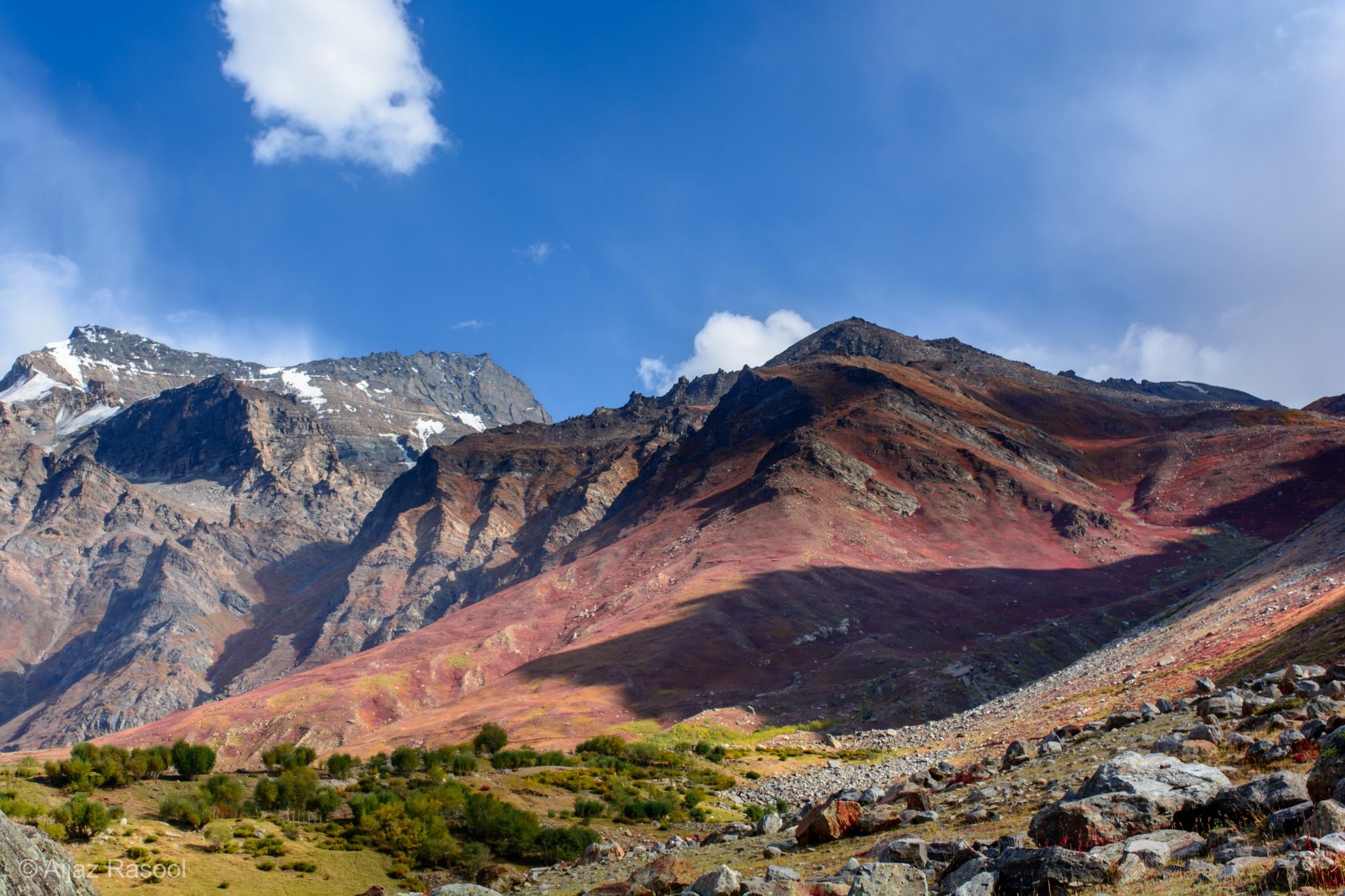
Final Silence: Looking Back at a Blue Without End
You leave Panikhar quietly. There is no farewell ceremony, no crowd to wave you off. The road simply resumes, and with it, the pull of elsewhere. But even as you descend the winding path that brought you here, something resists departure. It clings—not to your shoes, but to your rhythm.
The remote Himalayan village you walked through is now behind you, yet still somehow present. The sky—vast and unroofed—has folded itself into your gaze. Your breath, once labored at altitude, now feels shallow. You are moving faster, and yet it feels like forgetting.
And perhaps that is the mark of Panikhar’s offering: not something you take with you, but something you leave behind—noise, urgency, the illusion that more is better. You return with less, and that is its quiet gift.
In the days that follow, you’ll find its echoes in unexpected places. In the way you pause before answering. In how you look at the sky through windows. In the silence between your thoughts. Panikhar has not disappeared. It has simply rearranged your sense of distance.
For those seeking hidden gems in Ladakh, Panikhar may not appear on glossy lists or travel blogs. It does not advertise. It does not entertain. It waits. And in that waiting, it invites only those willing to slow down enough to see what can’t be photographed.
If you ever return—and many do—it will not be for novelty. It will be for continuity. For the chance to sit again on a low wall and watch the wind ripple through the barley. For the taste of butter tea poured without words. For the moment when, looking up, you realize that the sky is no longer above you—it is within you.
In the end, there is no itinerary for what Panikhar gives. No price for it. No proof. Only the certainty that in a small village in Suru Valley, you looked at the world from above its roof, and found a silence vast enough to carry home.
About the Author
Edward Thorne is a British travel writer and former geologist whose prose is marked by sharp observation, restrained emotion, and an unwavering devotion to the physical world.
He does not describe feelings — he describes what is seen, heard, touched. And in those descriptions, readers find the silence, awe, and disquiet of remote landscapes.
Educated in geology and cartography at Oxford, Edward spent over a decade mapping the tectonic margins of Central Asia. But it was in stillness—not data—where he discovered his voice. His writing eschews ornament in favor of precision. A shadow on a ridge. The hum of wind through prayer flags. A footprint in melting snow.
Today, Edward walks. And writes. He follows the forgotten lines between mountains and people, searching for the spaces where terrain becomes memory. His stories are not about escape. They are about attention.
When not in the highlands, Edward lives in a stone cottage in the Lake District, where he tends to moss, maps, and silence.

